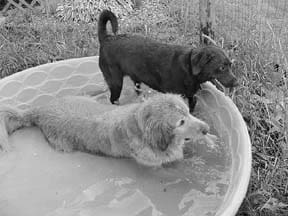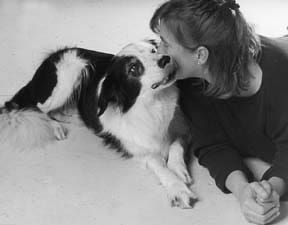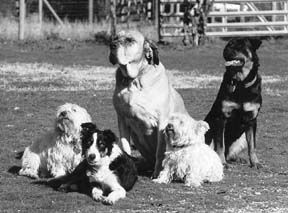Chewbacca is, in most ways, a normal, happy, seven-year-old Golden Retriever. He loves to play with the other dogs. Like most Goldens, he enjoys a good game of fetch. He joyfully embarks on daily off leash romps with his guardian, Jenny Alt, and her three other dogs. Chewbacca has one trait that makes him just a little different, however. He cannot see.
Alt and her husband share their home in Lena, Illinois, with Chewbacca, another blind dog named Iris, and two sighted dogs named Honi and Bear. The Alts adopted Chewbacca in 1997 when they were looking for a companion for their older Golden Retriever. As soon as Alt saw Chewbacca on a Golden Retriever Rescue Web site, she knew Chewbacca was going to be her dog. Alt’s experience with Chewbacca has been so positive, that several years later she adopted Iris, a chocolate Lab pup who was born blind.

While some dogs, like Chewbacca and Iris, are blind from birth or a very young age, others develop vision problems later in life. Blindness can be caused by a multitude of genetic disorders, diseases, or traumas. In some cases, dogs gradually lose their vision. In other cases, dogs may lose eyesight overnight. Depending on the disease or condition, a dog can lose partial vision, lose sight in one eye only, or become completely blind in both eyes.
Though a dog losing sight can be traumatic for both the dog and the dog’s owners, in most cases the dogs do adjust to life without sight. “They are so adaptable,” says Alt. However, a variety of factors can influence how well and how quickly a dog adapts.
According to Caroline D. Levin, the author of Living With Blind Dogs, dogs who are born blind seem to have the easiest time of it. “They don’t miss seeing,” said Levin, “because they have never had it to miss.”
Dogs who lose their vision slowly also seem to adjust well, maybe because they have time to adapt gradually. In some instances, dogs adapt so well that the people don’t notice the dog is losing vision. They may discover their dog is blind only when they move furniture or make other environmental changes, and the dog suddenly can’t find his way around.
Dogs who become blind suddenly or traumatically, however, may have a more difficult adjustment, said Levin. The dog’s age, personality, position in the pack, overall health, family life, and previous training will all impact how well the dog handles the transition from seeing to life without vision.
Levin was inspired to write Living With Blind Dogs when she managed a veterinary ophthalmology clinic. She witnessed people grieving their dogs’ loss of vision and realized that they desperately needed resources to help themselves (and their dogs) through the transition. Levin emphasizes that you can do a lot to help dogs adjust and live a full, happy life. “With training and time, it does get better,” Levin says, even for dogs who are initially depressed or frightened. “They can go on to have good lives.”
In fact, according to many people who have lived with a blind dog, after the initial adjustment the dog’s life becomes relatively normal. Many dogs who have lost their sight still can, and do, play with dog friends, splash in wading pools, romp off leash in safe places, and even chase squirrels. They learn to negotiate a home, stairs, yard, and regular walking routes with little or no assistance. They can retrieve toys, play tug, learn obedience, and generally be happy family members.
Discovering the lay of the land
All dogs – sighted or not – possess a skill called cognitive mapping. This same instinct allows them to find objects they buried weeks ago. Blind dogs use this skill to develop a mental map of the home and yard allowing them to race through the house looking very much like they can actually “see” where they are going.
Alt notes that someone who saw her dogs romping in their home or on their property may not know that two of them are blind. “They just run everywhere.” She says that it took Chewbacca only a day to learn the layout of their home, but Iris took a few months to learn how to navigate the stairs and other trickier aspects of their farmhouse and property.
Levin emphasizes that while dogs may map the layout of the home through trial and error, helping them is kinder and may make their transition easier. You can “show” dogs where things are and provide cues to help them navigate using their other senses. Alt agrees and says that when the environment changes, like a piece of furniture is moved, she needs to let the dogs know. “As long as I show them by touching it and saying, ‘See, this is here,’ they learn.”
Along with “showing” the dog where things are, certain aids may help them navigate the home. For example, you can use carpet runners to mark a clear path inside the home. The dogs can follow the path by noting the differences between its surface and the surrounding flooring. Doorways and steps can be defined using mats or rugs. Outside, you can mark paths for the dogs to follow using a simple mulched trail.
In addition to providing cues to the layout of the house, make sure the home is safe for the blind dog. In a way, this is very similar to puppy proofing a home. Levin suggests blocking off any stairways with a baby gate until the dog has learned to navigate them on his own. Keeping the furniture in the same place, pushing in chairs, and keeping pathways free of obstacles may all be helpful, but it’s also okay to move things around on occasion as long as you let the dog know. Blocking access to unsafe areas such as pools and ponds is essential.
For dogs who have limited vision or are blind only in one eye, using nightlights may provide visual cues to help the dog find his way around. Marking edges of steps and corners of furniture or walls with a contrasting tape may also help the dogs find their way safely through the house. In Living With Blind Dogs, Levin says that even dogs who cannot see the contrasting tape may actually find it beneficial, as the scent of the tape may help them locate the edge of the stair.
Heightened senses
Vision is only one of the many senses that dogs employ every day. Other senses include hearing, smell, and touch. Many experts believe that when a dog (or any other animal) loses one sense, his other senses become heightened. You can learn to communicate better with your blind dog and help him live a fuller life by taking advantage of these other senses.
Blind dogs most definitely learn to orient to sound and respond more to verbal cues. A dog’s sense of hearing is probably the easiest sense for people to take advantage of; most of us naturally talk, whistle, and use other sounds with our dogs. In fact, some of us have trouble not talking to our dogs. When you have a blind dog, you now have an excuse to talk nonstop to your furry friend. The sound of your voice can be reassuring and help orient her to your location. Of course, our voices can be used more directly to give a verbal cue for a desired behavior, too.
You can also take advantage of your dog’s sense of hearing in other ways. Wind chimes, for example, can be placed near the back door to help your dog find his way inside. Bells or noisy tags on your other animals may help your blind dog know who is where in the home. A tabletop fountain can be put in or near a water bowl to orient the dog to the bowl through the sound of running water.
Scenting specific objects in the home can also be very helpful, says Levin. She suggests “scent marking” the three most important pieces of the dog’s environment. For most dogs, those parts of the environment would be their food and water bowls; their beds, crates, or other safe spots; and the dog doors or other access routes to the outdoors. She says that if you mark each of these places with a different scent – using, for example, scented oils (like lemon oil) or cooking additives (like vanilla or almond extract) – the dog may be able to find these places with greater ease.
Alt notes that her blind dogs seem to crave physical touch. They enjoy lying across her feet or cuddling on the couch. Touching your dog may also become an important communication tool, and may be especially important for a dog who is deaf as well as blind. You can teach a dog that a “tap on the shoulder” means pay attention, or that a gentle touch to the rear means “sit.” In addition, teaching your dog to “touch” and follow your hand by scent may help you guide him, for example, through an unfamiliar gate or doorway.
Some dogs may startle if touched unexpectedly, especially if they had this tendency before they lost their eyesight. Just as you might condition a puppy to accept being startled and touched, a dog who has recently lost his vision may need to be conditioned to like unexpected touch. By pairing “touches” with great treats, you can easily teach a dog to accept the unexpected contact. Many dogs can actually learn to enjoy being startled.
Train for everyday activities
Training a dog who cannot see is similar in many ways to training a dog who does see. Luring a dog into position, for example, capitalizes on the dog’s sense of smell. He doesn’t need to see the treat to know it is in front of his nose.
Capturing behavior using a reward marker, such as a clicker or verbal “yes,” can be very effective with blind dogs, as this method depends on the dog’s hearing rather than vision. As with a sighted dog, learning basic cues like sit, down, stay, and come not only improves the dog’s manners, but also helps develop his confidence. In addition, a few specific behaviors can be particularly useful for a blind dog to learn.
• “Careful” or “easy” may be the most important behavior to teach a visually impaired dog. Teach your dog that the cue “careful” means, “Slow down or stop. There is something in front of you.” It may be easiest initially to teach this cue indoors, with your dog on leash. Start by walking with your dog, say “careful,” and assist your dog in stopping through a gentle pressure on the leash or by putting your hand across his chest. Reward him when he has stopped.
Once he has the idea and is visibly slowing or stopping on your verbal cue, you can practice “careful” as you approach an object such as the couch or a wall. Once he has stopped, you can let him move forward enough to discover the object in front of him, but don’t let him actually walk into the object. With several repetitions, your dog will learn that “careful” means that something is directly in front of him. Levin notes that this cue is also helpful if your dog becomes disoriented or confused, as stopping can help him to reorient.
• “Run” or “go” lets your dog know that he is safe to run and may be an especially important cue for a young or high-energy dog. You can practice this in your yard or a safe open area. Just before releasing your dog to run, say the word “go” or “run.” Your dog will soon learn to associate the word with a wide-open space, free of obstacles and dangers.
• “Right” and “left” can be helpful for directing your dog around people or obstacles on walks, or for directing your dog toward a toy or ball. Levin suggests using a slight pressure on the leash to help your dog learn directional cues.
You may also have success with moving a treat past your dog’s nose and giving it a gentle toss. Your dog can orient both to the scent of the treat and to the sound of it landing on the floor. Or if you enjoy clicker training, you could “shape” a turning away or toward you behavior.
• “Step up,” “step down,” and “stairs” can be essential cues for a blind dog to understand. You can use “step up” or “step down” as you approach a step or curb, or as a cue for getting in and out of the car.
Consider teaching a separate cue like “stairs” for a full flight of stairs. When training a dog to navigate steps or stairways, Levin recommends starting on a single step or a small stairway, helping them to master the mini version before moving on to a full set of stairs.
Putting some type of physical clue, such as a rug or mat, at the top and bottom landing may also help dogs identify where the stairs start and end. Some blind dogs learn to take steps and stairs with little trouble; a little coaxing and a trail of treats can motivate them to take a step up or down.
“With Chewbacca, I just tapped the next step, physically helped him move one paw, then he would bring his other paw down,” says Alt. Chewbacca learned to go up and down stairs in a few tries. “But it was very different with Iris,” Alt confesses. Iris was timid, even afraid of the stairs. Going up wasn’t as bad, but teaching her to go down on her own took a couple of months, a lot of patience, and the aid of a non-skid surface. Both Levin and Alt emphasize that patience is key in teaching a blind dog to take stairs.
Games blind dogs play
Blind dogs, like all dogs, need to be active. Walking, running, and playing will help them maintain their health and live a longer, happier life. And, with a little modification, you can encourage your dog to participate in many of the same activities he enjoyed before losing his sight. For example, if your dog is a ball fiend, you can continue to play retrieving games with him. Many dogs will continue to find their toys and balls by sound and scent. If your dog has trouble retrieving a regular tennis ball or toy, however, you can use a ball with a bell, a scented ball, or a retrieve item that can be stuffed with a smelly treat.
Scent discrimination games are a great option for blind dogs and Alt says that these types of games seem to be second nature for her dogs. When Alt plays fetch with Chewbacca, she can toss a toy into a pile of like toys, and Chewbacca will have no trouble finding the current play object every time. For people and dogs who enjoy a more formal training experience, consider teaching the scent discrimination exercise used at the utility level of formal obedience competition.
Other toys and games that seem to be particularly attractive for dogs who cannot see include tug games, food balls (the type the dog noses around a room, dropping treats as it goes), squeaky toys, “Wiggly Giggly” balls, and food-stuffed toys such as Kongs or Toppls.
Many blind dogs, especially after their initial adjustment period, will also enjoy adventures outside the home. On-leash, neighborhood walks are a safe bet for most dogs. But can blind dogs also enjoy off-leash romps? With supervision, some can, depending on the dog and the specific environment. For example, Alt is able to walk her dogs off-leash near her home.
“Walking in the same direction each day helps,” said Alt. Her blind dogs remember the path much the way they remember their way around the house. “If we go the other way though, they will be a little more confused,” she says. Having a warning word is essential, Alt adds, and her dogs know to stop and take a different route if she says, “careful.” Alt also says that a click of her fingers or clap of the hands will help orient her dogs and bring them running back to her if they do get confused.
In less routine environments, however, letting a blind dog off leash may simply be too dangerous. “You do need to protect them more than other dogs,” said Alt.
Social lives
Can blind dogs live happily with other dogs? Absolutely – if they get along with other dogs and are generally a candidate for a multi-dog household. Several owners of blind dogs told me that not only did their blind and sighted dogs do well together, but that the sighted dogs become, in some ways, “seeing eye dogs” for the blind dogs. One woman reported that she could send her sighted dog into a field after her blind dog if the blind dog became confused. Another said that her newly blind dog began following her sighted dog around the home and seemed to find a sense of security in knowing his canine pal was just ahead.

Levin mentioned that it might be important to use caution around other dogs with a newly blinded dog in the home. Shortly after losing his vision, a dog may be insecure or frightened and behave differently with the other dogs at first. All of the dogs may need an adjustment period, and Levin emphasized that strong leadership on the part of the person is very important at this stage.
Levin also noted that puppies born blind may initially have a difficult time with dog-to-dog interactions because they cannot see and respond to another dog’s body language. For example, an older dog may rebuff an overbearing puppy through body language first, before escalating to a more severe reprimand. If the puppy cannot see and respond appropriately to the older dog, he may get a harsher correction than he deserves. In addition, a blind dog may not see another dog send a friendly signal, such as a play bow. If the dogs’ interactions become confused, it may be necessary for the person to step in and help the dogs interact appropriately.
Not all blind dogs – even those born blind – have trouble with dog to dog communication. Alt is in the unique situation of not only sharing her home with four dogs, but also of providing rescue work for other dogs and for some wild animals. She doesn’t know whether her two blind dogs “learned” body language, or just instinctively knew how to respond to other animals, but both do very well with the family dogs and visiting dogs. Alt says that while the blind dogs may initially be afraid of a new or strange animal in their home, they do adjust quickly.
Dogs who live in the same home or who have regular play sessions seem to learn to communicate in ways that work for both the sighted dog and the blind dog. A sighted dog may adjust his communication style to better engage a blind friend. For example, when Iris wants to play with her dog friend Bear, she picks up a toy and entices him with normal canine body language. When Bear wants to play with Iris, he may initially try to engage her with common play signals such as the play bow. But because Iris can’t see his play antics, Bear has learned to paw her as an invitation to play.
Heart connections
Alt says that she really identifies with the saying, “Blind dogs see with their hearts.” To her, living with blind dogs is a very special experience, and one she cannot imagine living without. According to Alt, the relationship with a blind dog can go to an even deeper level than with other dogs. Perhaps it is the blind dog’s desire for contact and physical touch (a quality most people are drawn to) or our very human desire to be needed. Whatever the reason, for many of those who share their lives with blind dogs, the relationship is very rewarding.
■ Cataracts. A cataract is a cloudy change in the lens of the eye. Cataracts are classified according to the age of onset and can appear from birth (congenital), up to about six years of age (developmental or juvenile), or as the dog grows older. Cataracts can be inherited or caused by diseases such as diabetes. Some forms of cataracts do not seriously affect vision, but other forms can lead to blindness. The only treatment for cataracts is surgery, which is often successful in preventing blindness.
■ Progressive Retinal Atrophy (PRA) or Progressive Retinal Degeneration (PRD). PRA and PRD are a “family” of seven genetically inherited diseases. In PRA and PRD, the retina gradually shrinks and the dog loses vision over time. This condition is not painful, but usually causes vision loss in both eyes. It can occur as young as six months or later in life at five or six years of age.
■ Glaucoma. Glaucoma causes a build up of pressure inside the eye. It can be very painful and is a frequent cause of blindness in both people and dogs. Treatment can sometimes save the dog’s eyesight, but if glaucoma becomes more advanced, the dog may lose vision. Surgery can relieve the pain caused by glaucoma.
■ Sudden Acquired Retinal Degeneration Syndrome (SARDS). While this condition is not as common as some eye problems, the incidence of SARDS, first reported in 1980, may be increasing. SARDS causes sudden and complete blindness, but the exact cause of SARDS is not known.
If you suspect your dog has a vision problem, consult with your veterinarian right away. As noted above, treatment can often reduce the symptoms of eye problems, and sometimes even save vision.
Also With This Article
“Blind Dogs Can Have Normal Lives Too”
“Structure of the Canine Eye”











